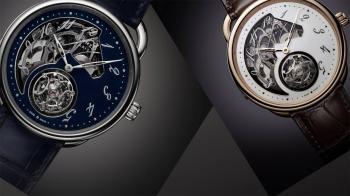“In the beginning was the Word, and the Word was with God, and the Word was God.” Thus opens the Gospel of St. John in the New Testament, in one of the most famous lines ever written about theology and epistemology — the concept of an absolute guiding power that shapes our world and everything we know about it. Besides its obviously religious application, the line also functions as a broad observation about any established field of knowledge, in which there are fundamental truths to be accepted and built upon but never challenged or replaced. Like, for example, haute horlogerie.
When I first started out writing about watches, I was told by the first watch journalist I ever met that the brands at the top of the watchmaking pyramid were Patek Philippe, Vacheron Constantin and Audemars Piguet, the so-called Big Three of horology. This being one of the first pieces of information I ever received about watch culture from someone more experienced than me, I took it as gospel, without really inquiring about all the whys and wherefores behind it. Those who’ve known me for any amount of time will recognise this as anomalous behaviour on my part. After all, the litmus test for determining if you’re actually speaking to Suzanne Wong the watch writer or some other Asian chick with red hair is to see if she’s asking endless questions about stuff when everyone else has already moved on to another topic. But as I said, this was back when I was first starting out. I worked at a big media conglomerate with a fairly rigid culture where it was frowned upon to question your senior colleagues.
After a few months in the industry, however, I came to realise that the entire idea of a Big Three was completely antithetical to the intimate and detail-focused nature of fine watchmaking. The watches and watchmaking philosophies of those three brands are indeed exceptional and may be considered a standard that we all admire and seek to emulate. But progress is rarely linear; quality evaluation is made on several axes, in several dimensions. It is impossible (and disingenuous) to state unequivocally that one brand is better than all the others.
In fact, we can’t even say if one factor definitively imparts tangible advantage to a brand. Is a brand automatically more prestigious or respectable the older it is? Clearly not, when you see the amazing work done by relatively young companies like De Bethune. Is a watch automatically better because it has more horological complications? Of course not — just look at the devastatingly exquisite time-only Chronomètre Contemporain by my friend Rexhep Rexhepi of Akrivia. Is a brand superior to the others just because its watches are more expensive or well-known? I don’t think I even need to answer that.
I’ve spoken with members of the watch community who still cling to outdated ideas like the existence of the Big Three. These are guys who would never even dream of looking seriously at a watch made by Louis Vuitton, Chanel, or Hermès. Ironically, it’s usually a snob thing, because they don’t believe that these giants of the world of consumer luxury have adequate legitimacy in watchmaking. Never mind the many examples of truly innovative and mechanically impressive timepieces that have emerged from these brands. And then these guys get mad when you apprise them of the fact that the people making movements for those brands are the same ones making movements for their favourite “geek” brands.
It gets on my nerves — at least until I remember that I, too, used to believe things without asking why. If there’s one thing that I’ve learned from my religious life, it’s that a robust faith is also a questioning faith. Things get stronger when you test them. If they withstand challenge, great. If they break, you find out where they need to be fixed and improved. The motto of A. Lange & Söhne, a brand inexplicably and unjustifiably (and infuriatingly) excluded from the so-called Big Three, is “Never Stand Still”. Speaking as someone who hasn’t set foot in a gym or done any kind of sporting activity since she was at university, this phrase is triggering in many ways. But I agree with it from the depths of my heart. What’s more, I believe in it.









